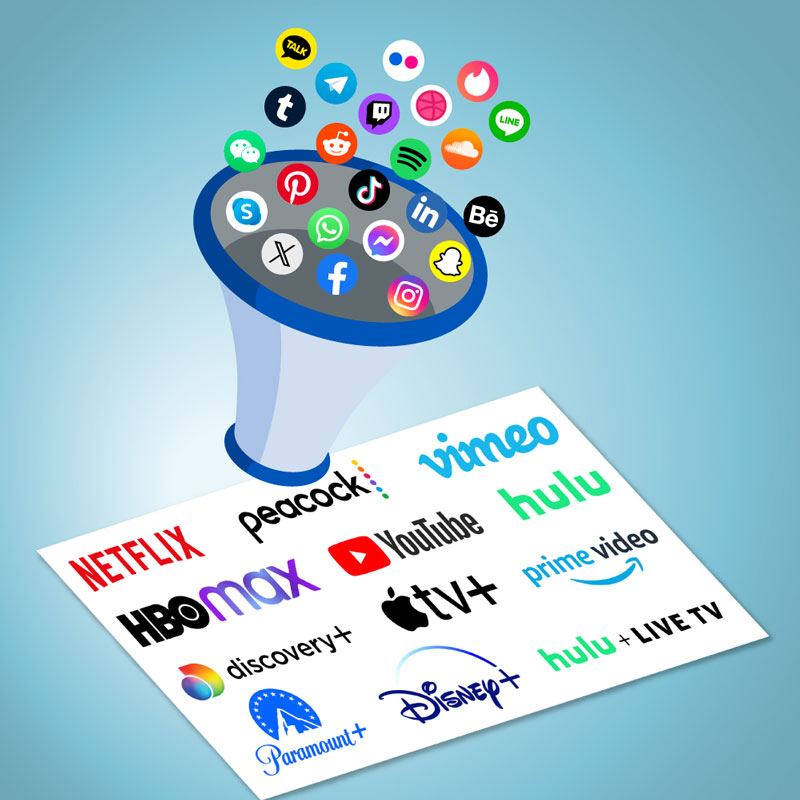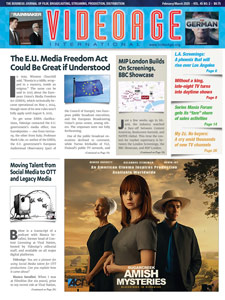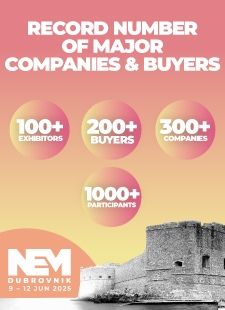The world is being inundated by FAST channels and AVoD platforms. The former are based on a linear programming structure, the latter on an on-demand offering. Both are delivered via streaming platforms. These days, newly created companies boast hundreds of YouTube channels, and broadcasters are jumping on the FAST channels bandwagon in order to recoup the audiences they lost on their generic networks with their thematic FAST channels.
Meanwhile, thematic cable-TV channels are losing out due to cord-cutting, and have been forced to migrate to streaming with free, ad-supported television channels (FAST, precisely).
The increased number of streaming channels (of all kinds: SVoD, AVoD, and FAST), combined with labor strikes –– first the writers, then the actors –– in Hollywood, have created an enormous demand for talent that was cultivated in the Social Media space, and has now been harvested by traditional media to feed their numerous OTT (Over The Top) channels, as the mainstream streaming outlets are called.
These days, in the U.S., for example, it’s nearly impossible to watch broadcast TV shows like Entertainment Tonight (on CBS) or Access Hollywood (on NBC) unless you’re next to a 12-year-old. Why? Because adults likely wouldn’t know who the reporters are interviewing or who the TV hosts are talking about. With the proliferation of influencers and Social Media stars, the entertainment world has been invaded by so many transient and mostly dim-witted personalities that only teenagers can keep track of them.
Teens the world over see many of these personalities as real “celebrities” — even if they’re just funny-looking folks posting videos of themselves on TikTok. There is even a promotional model developed around this seemingly strange phenomenon: Broadcast TV hosts invite Social Media celebrities onto their shows specifically so that said “celebs” promote the shows to their millions of followers online. This symbiotic relationship also allows the Social Media stars to expand into the OTT universe, thereby increasing their reach and getting them more sponsorships.
In the past, the generational divide was between those who could understand (and laugh) at the antics of John Cleese in Monty Python’s Flying Circus and those who simply didn’t get why anything he was doing would be considered funny. But at least everyone in a given family knew who Cleese was. Today, the divide is as wide as the Red Sea. Even The Wall Street Journal recently acknowledged, “Scores of online personalities enjoy status among children, yet most parents have no idea who they are, why they are famous or even how to watch them.”
Many Social Media viewers (billions of them, in fact), are now consuming content on OTT platforms, and one can spot them looking at their iPhones on subways, busses, trains, in the back seats of cars, and even on bicycles going against traffic or riding on sidewalks — everywhere, it seems, except in their homes.
Apparently, nowadays, watching broadcast television at home is something that only older people tend to do. In the last U.S. broadcast network TV season (which ended in May), the median viewer was older than 60 for most entertainment shows.
According to various researchers, there is a distinct generational divide for broadcast viewing starting at the age of 45. Boomers still cling to old viewing habits, and younger people watch the same shows, but on streaming platforms. For example, ABC’s Abbott Elementary, which has a median viewer age of 60.5 on broadcast TV, is also popular with younger viewers when it is streamed on Hulu.
But, since older viewers watch a lot of television, advertisers love them and their spending power. And, considering that many new people pass the threshold age of 45 every year, a fresh supply of viewers is assured to watch traditional TV at home.
Meanwhile, considering the large number of YouTube channels, other AVoD, and FAST channels, the amount of new content needed is astonishing. In July 2023, YouTube was the most-watched streaming platform in the U.S. with 9.2 percent of overall viewing time (according to Nielsen). Netflix was second with 8.5 percent. The YouTube platform operates as an aggregator and the powers that be at various channels like it because it offers an ecosystem similar to a cable TV operator.
With 14 million active YouTube channels from over 1,000 partners worldwide, plus an estimated 3,000 AVoD channels from other world operators (though we only know for sure that there are 1,500 of these in the U.S.) and 1,500 FAST channels around the world (75 percent of which are U.S.-based), the need for new content is astronomical. It is a totally different ball game than traditional television, which in comparison, is limited in both scope and reach.
AVoD and FAST channels are based on a long-tail model where content in low demand can make up market share that rivals blockbusters, but only if the distribution channel is large enough. And this drives the quest for the channels to be on multiple platforms.
A good portion of AVoD and FAST content consists of existing film and TV library material, with a smaller portion of that coming from licensing deals on a revenue-share (rev-share) basis, which only a few established distributors are willing to do, and only with the 10 major players, such as Pluto, Roku, Tubi, Vudu, or Freevee.
However, the bulk of this new type of content is generated by talents that are migrating from the Social Media environment into the OTT ecosystem in order to maximize their revenues, and all is driven by viewing data: research on the type of content favored by this type of audience. This kind of content production doesn’t allow for creativity. They don’t look at what could work — only what is working now.
If these videos can be transferred from a vertical format (typical of iPhones) to a horizontal format (for TV screens), the clips are then tied together in post-production with interstitials, a term for short TV shows that air between a channel’s primary programming.
The business model of both AVoD and FAST channels is advertising-based, mostly administrated by a “programmatic” system. Programmatic advertising is the use of automated technology for media buying (the process of buying advertising space), as opposed to traditional methods of TV advertising (calling on clients). Programmatic media buying utilizes data insights and algorithms to serve ads to the right user at the right time, and at the right price. Some streamed channels can also have a mix of programmatic and traditional ad sales. Two-minute ads are usually inserted every eight minutes per hour, and on average in the U.S., channels receive between $7 to $10 CPM.
This aspect of the streaming ad business opens up another set of “problematic” issues. Commented Gustavo Neiva de Medeiros, president of the New York City-based FAST Alliance, “Determining CPMs in the FAST advertising ecosystem is complex and varies significantly due to numerous factors. The lack of transparency is a challenge, especially for publishers without direct ad server relationships. The key issue is distinguishing the average revenue received by publishers (channels) from what platforms or intermediaries receive. While a channel might average $7, the platform or intermediary could earn $20. Addressing this disparity is a key area where the Alliance aims to assist publishers.” In addition, some ad servers carry monthly fixed costs and ad manager fees. For comparison, YouTube sells advertising averaging U.S. $33 CPM.
The split between the platform and the channel is usually 50-50, but some platforms ask for 60-40 in their favor, and others 45-55 in the channel’s favor. Out of their portion, the channel pays the talent and/or the company that they acquired the content from. The split with the talent/acquisitions is confidential and on a case-by-case basis.
Usually, large content owners can develop their own streaming channels, or they can license the content to third parties on a rev-share basis. The third parties brand the channels as their own, but in most cases the technical aspects are farmed out to specialized companies, like the Toronto, Canada-based Nextologies, which takes the “assets” (i.e., content) and programs them in a server following a “play list” provided by the content owner, with a process called a “play out.”
According to the Middlesex, U.K.-based Digital TV Research, global Free Advertising Supported Television revenue is now an $8 billion industry. Currently, the U.S. accounts for 56 percent of the total FAST business. Global FAST revenues are expected to increase by $9.4 billion between 2023 and 2029. This compares to $39 billion in global revenue for AVoD channels (the U.S. accounting for 40 percent) in 2023. The growing number of FAST channels cannot yet compete with the 900-pound gorillas represented by the AVoD channels offered by the U.S. studios, with streaming platforms such as Disney+, Hulu, and Netflix, all of whom have recently “discovered” that consumers who cut cable TV subscriptions to save money couldn’t afford to pay for full-rate streaming subscriptions, and instead moved services to their ad-supported lower-cost streaming versions.
Those U.S. households that still stick with cable spend about $103 a month on average for cable TV (which often includes broadband service), according to the New York City-based S&P Global Market Intelligence. This compares to an average $54 monthly subscription fee for streaming media (plus the cost of broadband/Internet service).
However, due to several challenges with streaming platforms (competition, high cost of operation, piracy, high churn, loss of subscribers, and last but not least, search fatigue), the studios have introduced advertising in order to have a two-tier model: subs and ads. Since advertising is still based on a mass audience at once (not cumulative over long periods), streamers are also moving towards live television (with awards shows and sports). In effect, SVoD platforms and TV networks are losing out to AVoD and FAST channels.
This new “viral” ecosystem that is now engulfing the international TV industry is also flooding the market with low-cost, low-quality content that is financed on a rev-share basis, with the talents absorbing most of the initial financial burden. Nonetheless, this new ecosystem is shaping up the TV sector with seminars galore about AVoD and FAST channels, and new trade publications are popping up, like Viral Media, edited by veteran journalist K Dass in Singapore.
Some of this new Social Media content that manages to move to OTT with broadcast-quality results is subsequently licensed worldwide by established international distributors. The New York City-based FilmRise, for example, licensed Preston & Brianna, a popular YouTube reality show.
Similarly, distributors with extensive film libraries, such as the Los Angeles-based Multicom, license content, in the words of Jesse Baritz, Multicom’s vp of Content Acquisition & Development, “to all different kinds of media, including for their own FAST channels.”
(By Dom Serafini)
Audio Version (a DV Works service)












Leave A Comment